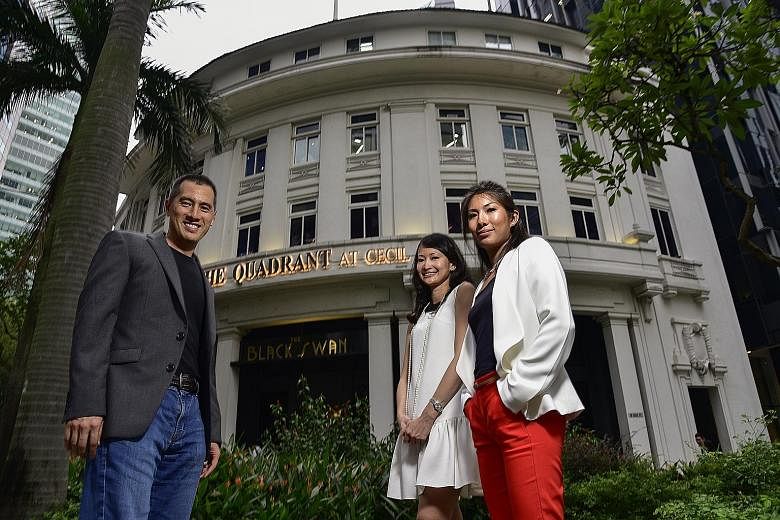Most building conservation efforts in Singapore are led by the Urban Redevelopment Authority (URA), which decides what to add to the country's stable of 7,000-plus protected structures.
In a rare case, a group of heritage enthusiasts, including executives from a property company, banded together to have the building they rent - The Quadrant in Cecil Street - gazetted for conservation by the URA.
About $1 million of the company's money was spent restoring it. It started off as just another project for Homestead Group chief executive Low Jeng-tek, portfolio asset director Sue Ann Lim and design lead Sue Lynn Oliveiro, whose company specialises in refurbishing heritage properties for new uses.
As master tenants, they were sprucing up the dilapidated building in the Central Business District and turning it into a tech office complex after taking over from a childcare operator in 2012. They had signed a nine-year lease with the Singapore Land Authority (SLA).
They soon began uncovering stories about the 1930s low-rise landmark's history and architectural merits, prompting them to question why it had yet to be protected.
-
Successful cases
-
The Urban Redevelopment Authority (URA) has in place a scheme that allows owners of private buildings to volunteer their buildings to the authority to be considered for conservation.
The URA assesses the merits of these proposals and the respective buildings for conservation, taking into account the longer-term plan for the area in question. There have been a handful of such gazettes in the last decade.
•The three-storey Parochial House of St Joseph's Church, which once served as the headquarters of the Portuguese Mission in Singapore, was gazetted for conservation last year. The building is an example of the traditional Portuguese baroque style, with distinctive features such as pointed Gothic arches and pinnacles with crockets - a hook-shaped decoration - adorning the roof.
•The owner of a corner shophouse along North Bridge Road at the junction of Liang Seah Street volunteered his building for conservation, which led to the owners of four neighbouring shophouses subsequently doing the same. Among these five buildings stands a pair of corner shophouses that are mirror images of each other in their neo-classically influenced facades. These were gazetted in 2009.
•A one-storey bungalow at 9, Buckley Road, likely built in the early 1900s, was gazetted in 2008. It features a mix of baroque and classical styles in its decorative approach.The house has a grand porch that emphasises its symmetrical layout. Volunteered for conservation by City Developments, the house was once the family home of the founder of the development company.
SOURCE: ST FILE, URA
Last month, Mr Low's former classmate, heritage enthusiast Gareth Lee, sent a letter to the URA proposing its conservation.
The letter by Mr Lee, 49, the vice-president and Asia-Pacific general counsel of an American healthcare company, described The Quadrant as an "art deco structure which sits at the gateway to Raffles Place and Marina Bay", and a "lone relic" of pre-WWll Singapore in an area dominated by skyscrapers.
The Homestead executives had shared their findings with him:
•The Quadrant had served as the South-east Asian headquarters of the Kwangtung Provincial Bank, which was used by immigrant Chinese to remit money, and its original banking hall layout and bank vault were still intact.
•It was set up by finance minister T.V. Soong of the Republic of China, brother-in-law of Chinese revolutionary Sun Yat Sen.
Their year-long restoration also brought back to life its original iron-gate traction lift - one of the few remaining in Singapore.
Mr Low told The Straits Times: "Our lease expires in 2021. Our worry is that the historical and architecturally unique building could one day be torn down and replaced by a skyscraper, given the value of land in the district.
"While we are still the stewards of this property, while it is still in our care, we must do something to ensure it stays beyond this date."
A Facebook group, Conserve The Quadrant, has been set up.
Most ground-up efforts to conserve buildings are usually led by owners of private buildings under the URA's voluntary conservation scheme. A URA spokesman said there have been "a handful" of such cases over the last decade, including the Parochial House at St Joseph's Church in Victoria Street.
Independent conservation bids by non-owners are even rarer.
Experts whom the group contacted, including cultural geographer Lily Kong, expressed surprise that The Quadrant had yet to receive conservation status.
A possible reason is that a road reserve line runs across the building.
Professor Kong said the private sector stepping forward to propose its conservation would belie a nation coming of age "in which our values include pride in our history and heritage". She said: "As Singapore matures, it would be great not to rely only or largely on the Government for conservation. There is certainly a prima facie case for this building to undergo assessment."
The URA said it welcomes the suggestion, adding however that as there are no immediate plans for the site, "the merits of conserving the building will be studied as part of the larger plans for the area".
As custodian of state properties, SLA has been opening up places with "heritage value and historical charm" to optimise their use, said chief executive Tan Boon Khai.
Mr Low said juxtaposing older heritage buildings with modern skyscrapers is an internationally proven "sure-fire way to attract creative techies like bees to honey".
He added: "Conserving The Quadrant will educate the public about our yesterdays, and also connect us to an innovative new tomorrow."


